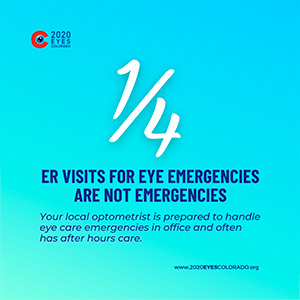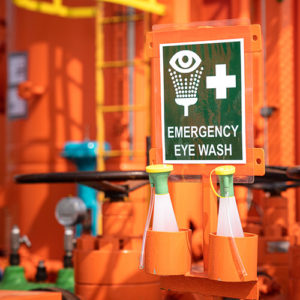If you had an eye health emergency today, do you know where to go for the best and most efficient care? We’ve all had health emergencies arise at one point in time and in most cases rushing to the urgent care or emergency room is appropriate. However, if the health issue is regarding your eyes or vision you may want to rethink your emergency plan. Eye doctors are prepared to treat most eye care emergencies in office and many eye doctors also have after hours care for these emergent eye care cases.

One study found that 25% of ocular ER visits were deemed non-emergencies and could have been handled in-office by an eye doctor. This means that patients paid a higher cost to be seen in the ER by a general healthcare provider rather than making an appointment with their eye doctor or utilizing the eye doctor’s emergent after-hours care. Individuals were 10% less likely to seek care in an ER for an eye condition if they had an established eye doctor.
Call your eye care provider first to see if you should be seen by your optometrist or if your situation is better addressed in the emergency department or urgent care. Seeing your eye doctor for an eye emergency is usually best because:
- Many emergency rooms and urgent care facilities lack the proper equipment for proper eye exams
- In an emergency room or urgent care facility you will probably see a general health practitioner rather than a specialized eye care professional like your optometrist
- Misdiagnosis could impact your vision and eye health permanently
“To get the best eye care in an emergency, we recommend that you have an eye health emergency plan. Eye care is essential so it’s important to have an optometrist that you see annually who can also address any eye care issues or emergencies that arise between your annual exams. Make sure your loved ones also have an eye care emergency plan for their own eye health,” says Dr. Jean DeMoss, President of the Colorado Optometric Association’s Board of Directors.
SYMPTOMS THAT NEED IMMEDIATE ATTENTION
- Black spots or flashes of light
- Curtain-like disappearance of vision
- Injury/trauma to the eye
- Eye pain (pain is an indicator of inflammation or injury)
- Seeing halos or rainbows around light
- Loss of peripheral (side) vision
- Sudden hazy or blurred vision
- Sudden vision loss in one eye
- Red, crusty or swollen eyelids
- Pupils are different sizes
- Sudden double vision
SYMPTOMS THAT NEED AN EYE EXAM SOON
- Blurred or double vision
- Excessive tearing or watering of your eyes
- Itchy, burning, or dry eyes
- Difficulty seeing in dark environments
- Seeing spots or ghost-like images
- Light sensitivity
- Eye strain and/or frequent mild headaches
6 COMMON EYE EMERGENCIES THAT YOUR OPTOMETRIST IS PREPARED TO TREAT
BLUNT EYE TRAUMA
Apply a cold compress without putting pressure on the eye to reduce pain and swelling.
- Severe pain or reduced vision require immediate care from an eye doctor.
EYE CUT, PUNCTURE OR FOREIGN BODY TO THE EYE OR EYELID
- Do not attempt to remove an object from your eye or eyelid.
- Do not wash out the eye for punctures, cuts or foreign bodies.
- Do not bandage the eye.
- Do not rub the eye.
- Protect the eye with a rigid shield, like sunglasses or the bottom half of a paper cup and see an eye doctor immediately.
CHEMICAL BURN OF THE EYE
- Flush eye(s) thoroughly with saline (preferably) or water for 15 minutes and get to an eye care professional immediately.
- For individuals with contact lenses, attempt to remove them first.
- Do not try to neutralize the chemical with another chemical or substance.

SUDDEN VISION CHANGES OR LOSS
Address quickly with your optometrist to avoid permanent vision loss and rule out more serious health issues like stroke, nerve damage, neurological issues, and retinal or corneal defects.
RED EYE
- Red eye with discharge needs to be examined by an optometrist as soon as possible for correct identification and treatment for the type of conjunctivitis (pink eye). Emergency rooms have a history of overprescribing antibiotics for conjunctivitis when 80% of cases are viral.
- Red eye could also indicate uveitis or ocular herpes, which can be sight-threatening making quick and proper evaluation by an eye doctor important.
PUPILS ARE DIFFERENT SIZES (PUPIL ANISOCORIA)
- If you were born with this condition, it is benign.
- If this is a new symptom, whether it’s constant or sporadic, schedule an exam with your optometrist as soon as possible as this could be vision threatening.
Article contributed by 2020 Eyes Colorado.
Ready to Schedule An Appointment?
The Highline Vision Center team is looking forward to seeing you soon. Our practice utilizes state-of-the-art technology to deliver personal and comprehensive eye care for your entire family.
